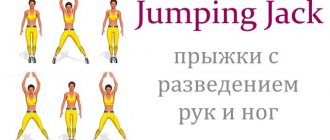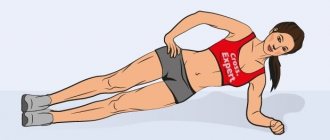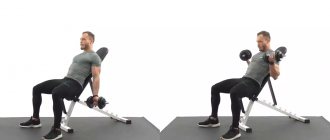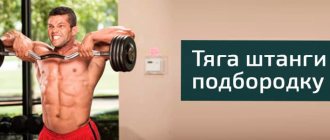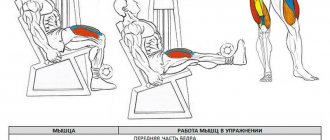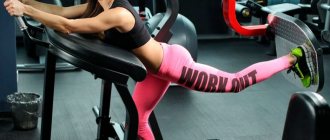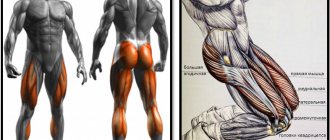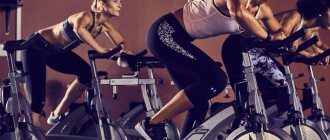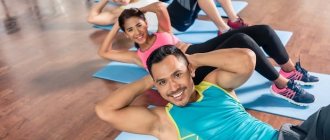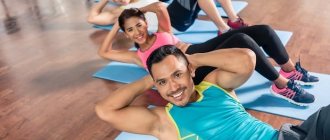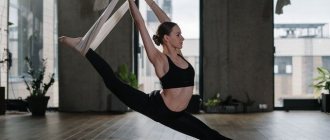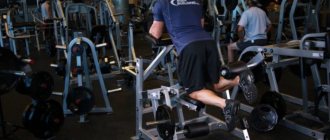Side lunges are used as an exercise to develop the buttocks and inner thighs. They help increase mobility in the hip joint and improve stretching. The exercise is used not only in bodybuilding, but also in training aimed at general physical training in running, crossfit and other related disciplines. Side lunges can also be used as a warm-up exercise for sumo-style deadlifts in powerlifting. Their use is justified for opening the hip joints.
What muscles are used by lateral lunges?
Unlike classic LUNCHES, in this version most of the load falls on:
- Adductor muscles of the thigh. These muscles are responsible for adducting the leg. They are especially involved when moving from one leg to the other. And during the squat, they stretch as much as possible.
- Gluteus medius and minimus. But these muscles perform the opposite function. They move their leg to the side. And when bending the legs, they act as stabilizers of the femur.
- Gluteus maximus. Responsible for leg extension at the hip joint. Most of the load occurs at the moment of exiting the squat.
- Quadriceps. Lateral lunges are one of the few exercises that make it possible to load the lateral head.
You can learn more about the muscles of the legs and pelvis from the article << ANATOMY OF THE LEGS MUSCLES>>
In addition to the main working muscles, the load falls on:
- Spinal erector muscles
- Abdominal muscles
Which act as stabilizers of the upper body. Without giving us the opportunity to lean forward.
The benefits and harms of exercise
Main advantages:
- Improved muscle tone;
- Improving the shape and definition of the hips;
- Ability to perform in any conditions (gym, home, playground, etc.);
- Improves the shape of the buttocks, especially the internal roundness;
- Development of coordination and balance;
- No harmful load on the lower back and joints.
There are no downsides to side lunges. The only drawback is technical errors. Mainly:
- Maintaining balance;
- Maintaining a straight back position;
- “Leg drop” is when the athlete abducts the leg and places the foot not softly, but literally falls on it without any muscle control.
Technique for performing side lunges without weight
It is better to master all exercises from an easier version. That’s exactly what side lunges with your own weight are. Thanks to their implementation, novice athletes will be able to get acquainted with the technique. Improve your neuromuscular connection with working muscles. This will allow us to better understand their role in this exercise. Despite its apparent simplicity, side lunges are technically complex. Therefore, it is worth taking their development seriously. Especially in the initial stages.
Performance:
- Stand up straight. Feet stand shoulder width apart. The feet are turned in the direction of the kneecaps.
- Place your arms in front of you, elbows slightly bent, hands clasped in front of your chest. Or you can lower them down.
- As you exhale, take a step in any direction. After your foot touches the floor, we begin to bend the outstretched leg at the knee joint. And we transfer our body weight to it.
- At this time, the second leg should be straight and stand on a full foot.
- Next, while inhaling, we straighten the leg and return to the starting position.
- We repeat the same in the opposite direction.
During the exercise, the abdominal muscles should be tense. Keep your back straight. Don't round it or lean forward too much. This will create additional stress on the knee joint. Flexion and extension of the leg should occur through contraction and stretching of the quadriceps and gluteal muscles. You need to squat until your pelvis is parallel to the floor. For people with poor flexibility, this can be an overwhelming task. Therefore, at the initial stage, squat as deep as possible.
What to do after stretching
Stretching after basic exercises requires a set of recovery procedures. It is imperative to adjust the water-salt balance. Replenish the deficiency of proteins and carbohydrates.
It is important to know that in order not to harm your health, you should never go out into the cold right away. While the muscles are very hot, you can get pinched under the influence of low temperatures.
If you feel emotional release after stretching, this is an indicator that all the exercises are being done correctly.
Execution options
Basically, side lunge variations mean performing this exercise with additional weight. This helps the athlete progress in muscle growth.
Side lunges with dumbbells
One of the most accessible weights are dumbbells. Thanks to their diversity, you can choose those that will match your level of physical development. There will be no changes in terms of technology. But there are some points to consider. Since we are working with weights, we will have to connect additional muscles to hold the dumbbells in our hands. To do this, you need to bring your shoulder blades together and push your chest forward a little. This way, it will be easier for us to maintain a straight back position during a squat. When working with heavy weights, do not slouch. We can place dumbbells in three variations. 1) Take one dumbbell in your hands. We hold it with our palms by one of the pancakes. And we put it in front of the chest, on bent arms. 2) We take dumbbells in each hand. We lower them down, between the legs. 3) Also, take two dumbbells. Only now, we place our hands on both sides of the working leg. Try all the options and choose the one that is more comfortable for you.
Side lunges with expander
This version of lunges is more suitable for girls. Since working with an expander increases the load on the gluteus medius muscle. The abducted leg must be placed firmly on the floor. Since, you will have to not only maintain balance, but also fight the tension force of the expander. Basically, it is placed on the ankles or thighs just above the knee. The technique remains the same, but the pace of execution decreases. This way we can control the work of the muscles in the eccentric phase (leg abduction and flexion), and concentric (return to the starting position).
Side lunges with barbell
Lunges with a barbell are given the least preference. What is this connected with? Firstly, it creates a large load on the spine. Secondly, holding weight on your back is considered more traumatic. Since, if it is impossible to stand up, it will be problematic to throw it off. Therefore, it is best to work with a partner. Thirdly, you will need more free space in the hall. That is, during hours when there are a lot of people (mostly in the evening), you simply will not be able to turn around. And instead of focusing on technique and working the right muscle groups. You will look around so as not to catch anyone. But despite all this, there is one significant plus. When working with a barbell, you don't have to think about whether your back is straight or not. After all, in order to place it on your back, you will have to bring your shoulder blades together. Therefore, the chest will automatically move forward. Straightening your spine. Otherwise, the technique is the same. We take the barbell from the racks. We place the bar on the rear delts. We take one or two steps back and perform side lunges.
Why do you need stretching?
Stretching is a mandatory step after physical activity. It is recommended that everyone involved in various types of fitness do muscle stretching exercises at the end of the main workout. Why is this so important:
- Improves elasticity and mobility of joints.
- Blood circulation increases. As a result, muscle pain disappears after physical activity.
- Blood pressure is restored and heart rate decreases.
- Endorphins are produced, which give the body a feeling of harmony and satisfaction.
If you ignore this stage, you can provoke not only general discomfort in the body, but also injury. Therefore, it is better to use the professional support of an experienced trainer.
Basic errors during execution
Incorrect weight
This is the most basic mistake that novice athletes often make. They think that heavy weight will allow them to develop their muscles faster. But the body is not yet ready for such stress. And the tendons and ligaments are not strong enough. Therefore, it is easy to injure them. To avoid this, you need to soberly assess your strengths. And select a weight with which you can perform the exercise technically correctly.
Rounding and tilting the back
This error most often occurs when working with dumbbells. Especially if they are located on the arms down. And under their weight, the back rounds. As a result, the center of gravity will shift. Which will create excessive stress on the spine. The same applies to strong forward bending. If you round your back with a barbell placed on it. Then she will jump down. And the consequences may not be the most favorable.
Step too long or short
The amplitude of movement and stability of position depend on the length of the step. If we put our working leg too far back with insufficient flexibility. Then, during a squat, in addition to pain in the groin area, the foot of the working leg will begin to lift off the floor. Because of this, we will lose our balance and fall. If we don’t move our leg far enough, we simply won’t be able to squat deeply. Consequently, the muscles will not reach their maximum stretch.
Shifting weight from heel to toe
When performing squats, it is very important to correctly distribute the weight across the foot. It is recommended to shift most of the load to the heel. This makes it easier to maintain balance. And, therefore, the knee joint and ligaments will not have to act as stabilizers of the femur. When you focus on the toe, the opposite picture occurs. Balance deteriorates, thereby creating greater stress on the knee joint. Ultimately, this technique can lead to injury. And you will have to forget about training forever.
Contraindications
It is not recommended to perform exercises with inflammation of the hip and knee joints. Contrary to popular belief, they will not in any way affect the rehabilitation of this problem, but can significantly worsen the athlete’s condition. It is not recommended to plan movements unless there is an immediate ankle and foot injury.
Anyone who has no contraindications to squats can perform side lunges. If you have back problems, it is recommended to hold the weight in your hands rather than on your back.
5/5 — (11 votes)
Share link:
Tips for maximum efficiency
- Before starting any exercise, be sure to do a general WARM-UP. Particular attention should be paid to the knee and hip joint. And when working with weight, also the shoulder.
- To prevent your feet from slipping on the floor, it is best to use shoes with rubber soles.
- If you want to get the most out of the exercise. Then you should perform lateral lunges in the maximum possible amplitude.
- Once you have ideally mastered the classic version without weights. You should gradually add weights. To ensure that progress in muscle development does not stop.
- For greater impact, you can combine lateral lunges with SUMO or PLIE STYLES.
- At the end of your workout, be sure to stretch your leg muscles. This will allow the body to relax and move from work mode to everyday life. And plus, we will work on the elasticity of our muscles. And we will be able to increase the range of motion when performing lunges.
I think you are convinced that lateral lunges are worthy of becoming one of the working tools in the development of legs and buttocks. The main thing is to correctly include it in your training program. It is also very important to master the technique of performing these lunges. Avoid making gross mistakes and constantly increase the weight of the burden. And soon you will be surprised at how your muscles will change.
Good luck to everyone in your training!
Wide lunges with push-ups
Exercise technique
- stand in a plank position, place your right leg at the level of your right shoulder
- bend your elbows (as in push-ups)
- straighten your arms and change your working leg
- do one more pushup
- this is one repetition, 8-10 in total
